
A Zeppelin is a type of rigid airship named after the German inventor Count Ferdinand von Zeppelin who pioneered rigid airship development at the beginning of the 20th century. Zeppelin's notions were first formulated in 1874 and developed in detail in 1893. They were patented in Germany in 1895 and in the United States in 1899. After the outstanding success of the Zeppelin design, the word zeppelin came to be commonly used to refer to all rigid airships. Zeppelins were first flown commercially in 1910 by Deutsche Luftschiffahrts-AG (DELAG), the world's first airline in revenue service. By mid-1914, DELAG had carried over 10,000 fare-paying passengers on over 1,500 flights. During World War I, the German military made extensive use of Zeppelins as bombers and as scouts, killing over 500 people in bombing raids in Britain.
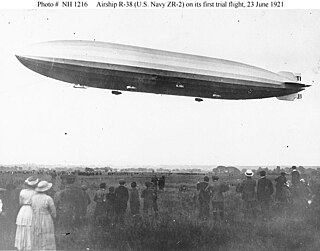
The R.38 class of rigid airships was designed for Britain's Royal Navy during the final months of the First World War, intended for long-range patrol duties over the North Sea. Four similar airships were originally ordered by the Admiralty, but orders for three of these were cancelled after the armistice with Germany and R.38, the lead ship of the class, was sold to the United States Navy in October 1919 before completion. On 24 August 1921, R.38 was destroyed by a structural failure while in flight over the city of Hull. It crashed into the Humber Estuary, killing 44 out of the 49 crew aboard. At the time of its first flight it was the world's largest airship. Its destruction was the first of the great airship disasters, followed by the Italian-built US semi-rigid airship Roma in 1922, the French Dixmude in 1923, the British R101 in 1930, the USS Akron in 1933, the USS Macon in 1935, and the German Hindenburg in 1937.
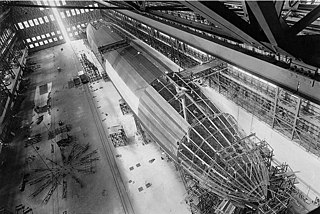
A rigid airship is a type of airship in which the envelope is supported by an internal framework rather than by being kept in shape by the pressure of the lifting gas within the envelope, as in blimps and semi-rigid airships. Rigid airships are often commonly called Zeppelins, though this technically refers only to airships built by the Luftschiffbau Zeppelin company.

The 23 class were rigid airships produced in the United Kingdom during the First World War. Development of the 23 class began in August 1915 when Vickers was asked to improve the 9r design by increasing its gas capacity by adding a bay and increasing the capacity of the bow and stern gas cells. The 23-class was designed by H.B. Pratt and Barnes Wallis of Vickers. Vickers built the first and last of the four ships. The other two were built by William Beardmore and Company and Armstrong-Whitworth. While the 23 class airships were never used in combat, the four ships provided many hours of valuable training and experimental data for British airship crews and designers. Although a total of 17 of these ships were contemplated at one time, only four were ever built. The 23 class was found to be significantly overweight, leading to its cancellation in favour of the more-refined R23X class.
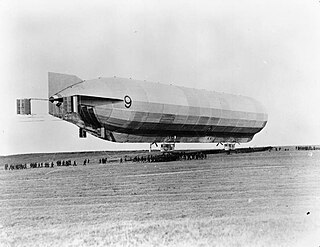
HMA No. 9r was a rigid airship designed and built by Vickers at Walney Island just off Barrow-in-Furness, Cumbria. It was ordered in 1913 but did not fly until 27 November 1916 when it became the first British rigid airship to do so. It was dismantled in June 1918 after being flown for around 165 hours, mainly for experimental purposes.
The best known German strategic bombing campaign during World War I was the campaign against Britain, although strategic bombing raids were carried out or attempted on other fronts. The main campaign against Britain started in January 1915 using airships. From then until the end of World War I the German Navy and Army Luftstreitkräfte mounted over 50 bombing raids on the United Kingdom. These were generally referred to as "Zeppelin raids": although both Zeppelin and Schütte-Lanz airships were used, the Zeppelin company was much better known and was responsible for producing the majority of the airships used. Weather conditions and night flying conditions made airship navigation and maintaining bombing accuracy difficult. Bombs were often dropped miles off target and accurate targeting of military installations was impossible. The civilian casualties made the Zeppelins an object of hatred, and they were dubbed "baby-killers". With the development of effective defensive measures the airship raids became increasingly hazardous, and in 1917 the airships were largely replaced by aeroplanes.

The Zeppelin LZ 1 was the first truly successful experimental rigid airship. It was first flown from a floating hangar on Lake Constance, near Friedrichshafen in southern Germany on 2 July 1900. "LZ" stood for Luftschiff Zeppelin, or "Airship Zeppelin"

The Zeppelin LZ 3 was a German experimental airship constructed in Friedrichshafen under the direction of Ferdinand von Zeppelin. It was first flown on 9 October 1906 and was later purchased by the German Army and operated as Z I until being retired in 1913. Before being purchased by the Army, LZ 3 made many flights and carried a number of influential passengers, including the German Crown Prince.

LZ 10 Schwaben was a German rigid airship built by Luftschiffbau Zeppelin in 1911 and operated by DELAG for passenger service. It is regarded as the first commercially successful passenger-carrying aircraft.

The Zeppelin LZ 4 was a German experimental airship constructed under the direction of Ferdinand von Zeppelin. First flown on 20 June 1908, it made a series of successful flights including a 12-hour flight over Switzerland. It was destroyed when it caught fire after landing to carry out engine repairs during a projected 24-hour endurance trial. This disaster proved fortunate for Zeppelin: donations by the German public raised 6.5 million marks, so guaranteeing the future of his development of airships.

LZ 18 was the second Zeppelin airship to be bought by the Imperial German Navy. It caught fire and crashed with the loss of all aboard on 17 October 1913 before entering service.

LZ 120 Bodensee was a passenger-carrying airship built by Zeppelin Luftschiffbau in 1919 to operate a passenger service between Berlin and Friedrichshafen. It was later handed over to the Italian Navy as war reparations in place of airships that had been sabotaged by their crews and renamed Esperia. A sister-ship, LZ 121 Nordstern, was built in 1920: it was handed over to France and renamed Méditerranée.
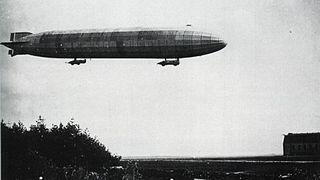
The Zeppelin P Class was the first Zeppelin airship type to be produced in quantity after the outbreak of the First World War. 22 of the type were built as well as 12 of a lengthened version, the Q Class . They were used for many of the airship bombing raids on the United Kingdom in 1915-16, for naval patrol work over the North Sea and Baltic and were also deployed on the eastern and south-eastern fronts.

Zeppelin LZ 38 was Zeppelin P Class airship of the German Imperial Navy. It was the first to bomb London, United Kingdom.
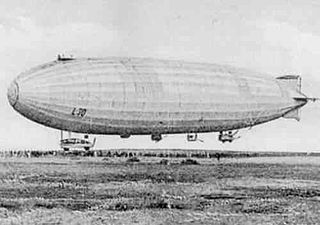
Zeppelin "L 30" was the first R-class "Super Zeppelin" of the German Empire. It was the most successful airship of the First World War with 31 reconnaissance flights and 10 bombing runs carrying a total of 23,305 kg of bombs, with the first ones targeting England, and the four final raids targeting Livonia and Ösel (Saaremaa). At the time of its construction, It was the world's largest Zeppelin, and with its 6 engines, "L 30" could reach speeds higher than 100 km/h, making it the fastest Zeppelin in the world too.

The LZ 85, tactical number L 45, also known as Zeppelin of Laragne by the French public, was a World War I R-Class zeppelin of the German Navy that carried out a total of 27 flights, including 3 raids on England and 12 reconnaissance missions.
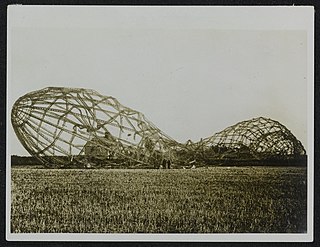
The Imperial German Army Zeppelin LZ 76 (L-33) was a R-class World War I zeppelin.

Zeppelin LZ 89 was an R-class zeppelin of the Imperial German Navy. After a short career during the World War I it ran out of fuel during a mission and was deliberately crashed.

LZ 74 was an R Class super-zeppelin belonging to the Imperial German Navy.

The Imperial German Army Zeppelin LZ 86 (L-39) was a R-class World War I zeppelin.



















